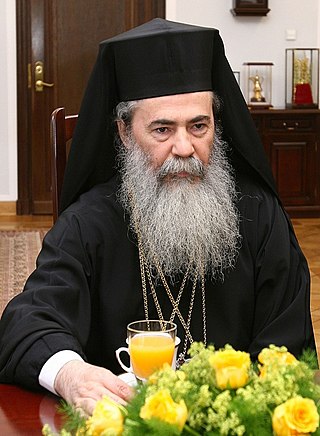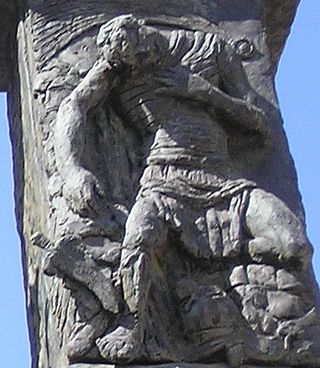
Aelia Capitolina was a Roman colony founded during the Roman emperor Hadrian's visit to Judaea in 129/130 CE. It was founded on the ruins of Jerusalem, which had been almost totally razed after the siege of 70 CE. This act marked a significant transformation of the city from a Jewish metropolis to a small pagan settlement dedicated to the cult of Capitoline Jupiter.

The 130s was a decade that ran from January 1, 130, to December 31, 139.

The Patriarch of Alexandria is the archbishop of Alexandria, Egypt. Historically, this office has included the designation "pope".

The Greek Orthodox patriarch of Jerusalem or Eastern Orthodox patriarch of Jerusalem, officially patriarch of Jerusalem, is the head bishop of the Greek Orthodox Patriarchate of Jerusalem, ranking fourth of nine patriarchs in the Eastern Orthodox Church. Since 2005, the Eastern Orthodox patriarch of Jerusalem has been Theophilos III. The patriarch is styled "Patriarch of the Holy City of Jerusalem and all Holy Land, Syria, beyond the Jordan River, Cana of Galilee, and Holy Zion." The patriarch is the head of the Brotherhood of the Holy Sepulchre, and the religious leader of about 130,000 Eastern Orthodox Christians in the Holy Land, most of them Palestinian Christians in Israel and Palestine.

This is a timeline of major events in the history of Jerusalem; a city that had been fought over sixteen times in its history. During its long history, Jerusalem has been destroyed twice, besieged 23 times, attacked 52 times, and captured and recaptured 44 times.

Syria Palaestina was the renamed Roman province formerly known as Judaea, following the Roman suppression of the Bar Kokhba revolt, in what then became known as the Palestine region between the early 2nd and late 4th centuries AD. The provincial capital was Caesarea Maritima. It forms part of timeline of the period in the region referred to as Roman Palestine.

Macarius I was Bishop of Jerusalem from 312 to shortly before 335, according to Sozomen. He is venerated as a saint within the Eastern Orthodox Church and Roman Catholic Church.

The Bar Kokhba revolt was a large-scale armed rebellion initiated by the Jews of Judea, led by Simon bar Kokhba, against the Roman Empire in 132 CE. Lasting until 135 or early 136, it was the third and final escalation of the Jewish–Roman wars. Like the First Jewish–Roman War and the Second Jewish–Roman War, the Bar Kokhba revolt resulted in a total Jewish defeat; Bar Kokhba was killed by Roman troops at Betar in 135, and the Jewish rebels who remained after his death were all killed or enslaved within the next year.

The Greek Orthodox Patriarchate of Jerusalem, also known as the Greek Orthodox Church of Jerusalem, is an autocephalous church within the wider communion of Eastern Orthodox Christianity. Established in the mid-fifth century as one of the oldest patriarchates in Christendom, it is headquartered in the Church of the Holy Sepulchre in Jerusalem and led by the patriarch of Jerusalem, currently Theophilos III. The patriarchate's ecclesiastical jurisdiction includes roughly 200,000 to 500,000 Orthodox Christians across the Holy Land in Palestine, Jordan and Israel.

Pentarchy was a model of Church organization formulated in the laws of Emperor Justinian I of the Roman Empire. In this model, the Christian Church is governed by the heads (patriarchs) of the five major episcopal sees of the Roman Empire: Rome, Constantinople, Alexandria, Antioch, and Jerusalem.
The archiepiscopal see of Caesarea in Palaestina, also known as Caesarea Maritima, is now a metropolitan see of the Eastern Orthodox Patriarchate of Jerusalem and also a titular see of the Catholic Church. It was one of the earliest Christian bishoprics, and was a metropolitan see at the time of the First Council of Nicaea, but was later subjected to the Patriarchate of Jerusalem. The city remained largely Christian until the Crusades, its bishop maintaining close ties to the Byzantine Empire. After the establishment of the Kingdom of Jerusalem by the crusaders, the see was transformed into a Latin archdiocese, subordinate to the Latin patriarch of Jerusalem.
The Patrologia Graeca is an edited collection of writings by the Church Fathers and various secular writers, in the Greek language. It consists of 161 volumes produced in 1857–1866 by J.P. Migne's Imprimerie Catholique, Paris.

Alexander I of Alexandria was the 19th Pope and Patriarch of Alexandria. During his patriarchate, he dealt with a number of issues facing the Church in that day. These included the dating of Easter, the actions of Meletius of Lycopolis, and the issue of greatest substance, Arianism. He was the leader of the opposition to Arianism at the First Council of Nicaea. He also mentored his successor, Athanasius of Alexandria, who would become one of the Church Fathers.
Saint Juvenal was Bishop of Jerusalem from 422. On the See of Jerusalem being recognised as a Metropolitinate by the Council of Chalcedon, he became the first Metropolitan of Jerusalem, an office he occupied until his death in 458. His jurisdictional reach over all three provinces of Roman Palestine would subsequently gain him the recognition as the first Patriarch of Jerusalem.

Jerusalem's role in first-century Christianity, during the ministry of Jesus and the Apostolic Age, as recorded in the New Testament, gives it great importance, both culturally and religiously, in Christianity. Jerusalem is generally considered the cradle of Christianity.
Judah Kyriakos, also known popularly as Judas of Jerusalem, was the great-grandson of Jude, brother of Jesus, and the last Jewish Bishop of Jerusalem, according to Epiphanius of Salamis and Eusebius of Caesarea. He is sometimes regarded as the great-grandnephew of Jesus.
Early Christianity, otherwise called the Early Church or Paleo-Christianity, describes the historical era of the Christian religion up to the First Council of Nicaea in 325. Christianity spread from the Levant, across the Roman Empire, and beyond. Originally, this progression was closely connected to already established Jewish centers in the Holy Land and the Jewish diaspora throughout the Eastern Mediterranean. The first followers of Christianity were Jews who had converted to the faith, i.e. Jewish Christians, as well as Phoenicians, i.e. Lebanese Christians. Early Christianity contains the Apostolic Age and is followed by, and substantially overlaps with, the Patristic era.
Justus I Bishop of Jerusalem, whose Jewish name is Judas, was a 2nd-century Jewish Christian leader and according to most Christian traditions the third Bishop of Jerusalem, whose episcopacy was about 107–113 AD. He succeeded Simeon the son of Clopas who died crucified in 107/108, or in 115-117. He is probably a son of James, brother of Jesus and sometimes identified as the New Testament's "Jude of James", otherwise Jude the Apostle. His successor Zacchea I is also called "the Righteous", since this is the meaning of the Aramaic Zakka.
![James the Just, whose judgment was adopted in the Apostolic Decree of Acts 15:19-29, "...we should write to them [Gentiles] to abstain only from things polluted by idols and from fornication and from whatever has been strangled and from blood..." (NRSV) Saint James the Just.jpg](http://upload.wikimedia.org/wikipedia/commons/thumb/9/96/Saint_James_the_Just.jpg/180px-Saint_James_the_Just.jpg)














